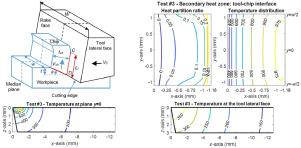International Journal of Mechanical Sciences ( IF 7.1 ) Pub Date : 2021-05-20 , DOI: 10.1016/j.ijmecsci.2021.106524 F. Veiga , M. Arizmendi , A. Jiménez , A. Gil Del Val

|
High temperatures generated in cutting processes significantly affect the surface integrity of machined parts and tool wear, leading to workpiece thermal damage, tensile residual stresses in the workpiece and a reduction in tool life. In recent years, different analytical thermal models to predict cutting temperatures have been developed in literature based on 2D modeling of the cutting process and the assumption that thermal conductivities of workpiece and chip are not dependent on temperature. However, this dependence of conductivity on temperature may have a significant influence on predicted temperatures and must be taken into account. In this paper, a thermal model of the orthogonal cutting process that considers thermal conductivity of materials (chip and tool) to be dependent on temperature is developed. A linear variation of thermal conductivity with temperature is assumed for chip (workpiece) and tool materials. The model is based on application of: (1) the Kirchhoff transformation in order to convert the nonlinear heat conduction problem into a linear one, (2) the theory of moving and stationary heat sources in semi-infinite and infinite mediums in order to model primary and secondary deformation zones and (3) imaginary heat sources to meet adiabatic boundary conditions in the chip and tool. Imaginary heat sources were defined in the thermal model proposed in this paper in such a way that the effect of the tool-chip interface dimensions and of cutting tool width on the tool temperature could be taken into account. This allows the temperature on the rake face and lateral faces of the tool to be predicted. To this end, a new methodology that considers the temperature-dependent thermal conductivity of materials was developed in order to estimate heat partition ratio along the secondary heat source (tool-chip interface), which is assumed to be non-uniform. Orthogonal cutting tests were also performed in order to verify model predictions by comparing them to tool temperature distributions measured using an IR camera.
中文翻译:

用于预测具有温度相关热导率的切削刀具温度的正交切削过程的解析热模型
切削过程中产生的高温会显着影响加工零件的表面完整性和刀具磨损,导致工件热损伤、工件中的拉伸残余应力和刀具寿命缩短。近年来,基于切削过程的 2D 建模以及工件和切屑的热导率不依赖于温度的假设,在文献中开发了不同的分析热模型来预测切削温度。然而,电导率对温度的这种依赖性可能会对预测温度产生重大影响,因此必须予以考虑。在本文中,开发了正交切削过程的热模型,该模型考虑了材料(切屑和刀具)的热导率与温度相关。对于切屑(工件)和工具材料,假定热导率随温度呈线性变化。该模型基于以下应用:(1) Kirchhoff 变换以将非线性热传导问题转换为线性问题,(2) 半无限和无限介质中的移动和静止热源理论以建模主要和次要变形区以及 (3) 假想热源,以满足切屑和刀具中的绝热边界条件。在本文提出的热模型中定义了假想热源,这样就可以考虑刀具-切屑界面尺寸和刀具宽度对刀具温度的影响。这允许预测刀具前刀面和侧面的温度。为此,开发了一种考虑材料的温度相关热导率的新方法,以估计沿二次热源(工具-切屑界面)的热分配比,假设该热分配是不均匀的。还进行了正交切削试验,以通过将模型预测与使用红外摄像机测量的工具温度分布进行比较来验证模型预测。











































 京公网安备 11010802027423号
京公网安备 11010802027423号